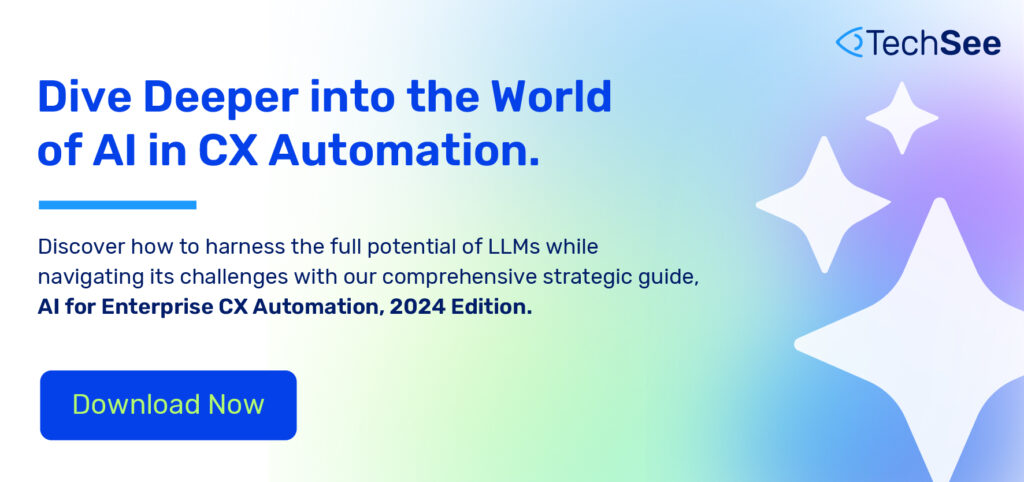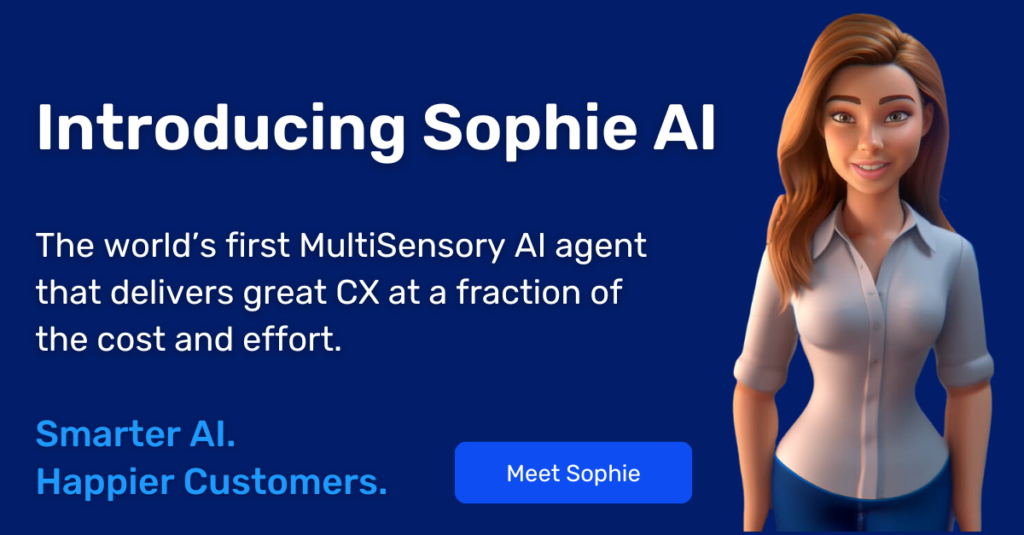Contents
Generative AI, such as Large Language Models (LLMs), will dramatically change multiple industries, including the service and customer experience (CX) space. This new class of technology brings incredible opportunity, as well as a new set of challenges. This post will explore the promise, the potential pains, and why you should take an optimistic view of this technology.
LLMs in CX: Opportunities
LLMs have become potent tools for enhancing customer experience (CX) through “smarter” automation. Their remarkable ability to understand and create natural human-like language should enable a new generation of conversational automation.
True conversational automation, made possible by LLMs, will unleash massive new opportunities for CX leaders. These include:
- Improved customer experience: LLMs can help businesses provide personalized and efficient customer service by automating routine tasks such as answering frequently asked questions, scheduling appointments, and, over time, much more.
- Cost savings: By automating customer service tasks, enterprise leaders can meaningfully augment Tier 1 human agents in contact centers and technicians in field service, thereby saving costs.
- Increased efficiency: AI such as LLMs can simultaneously handle multiple customer queries, reducing wait times and improving response times – without compromising CX or service quality. These initiatives may start as human-supervised AI automation, with agents monitoring multiple AI-powered customer interactions simultaneously.
LLMs in CX: Risks
However, the successful incorporation of such advanced technologies isn’t without challenges. This technology is new, many technology providers lack meaningful focus and experience in CX, and staffing experienced AI specialists is not easy. These issues can make it very challenging for enterprise leaders to implement successful CX automation.
- Accuracy: LLMs are trained on massive amounts of general knowledge. However, they lack expertise and experience in CX and service. While CX leaders can utilize these pre-trained foundational models for basic conversational FAQs, extensive specialization is required for AI to guide or automate customers in the real world accurately.
- Context: Unlike traditional chatbots designed around specific objectives, LLMs must be trained to ask multiple discovery questions and retain conversational history to create and maintain conversational context.
- Quality Assurance: LLMs are incredibly complex black boxes. It can be tough to track where, within a massive amount of documentation, the LLM misunderstood or misinterpreted the documentation and why the system came up with incorrect customer guidance.
- Reliability: LLMs are notorious for their propensity to provide inaccurate information. This is often called hallucination. In the customer context, this can lead to customer frustration and potentially even unsafe guidance and responses.
- Security and Safety: Not all information provided to agents or technicians should be provided to customers. Similarly, internal documentation is often proprietary and should only be uploaded to third parties with ironclad security policies. Mitigating this risk requires using a secure, hosted LLM provider and defining strict guidelines for the AI agent.
- Cost Effectiveness: AI tokens become prohibitively expensive and quickly. LLM training and fine-tuning consume further tokens. Just because an LLM can automate or augment a specific customer experience doesn’t mean that LLMs offer compelling savings or meaningfully better customer experiences. In order to address this challenge, leaders must (A) start with strategic, ROI-positive potential use cases and (B) deploy the right LLM optimization techniques to ensure both cost-effectiveness and customer satisfaction.
Capitalizing on New Opportunities While Minimizing Risks
How LLMs Improve and Automate Customer Experience
To recognize the dream of conversational CX automation, leadership must ensure that LLMs’ guidance is clear and accurate. This requires looking at LLMs as more than conversational user guides that can generate informational responses. LLMs should be as capable as Tier 1 agents and first-line technicians, able to answer questions and, most importantly, resolve customer problems quickly, efficiently, and at unlimited scale.
To achieve this level of CX automation, leadership should consider the following:
- Use MultiSensory CX to Provide Context: A picture is worth a thousand words. Combining visual AI with other AI tools like LLMs provides faster, more accessible customer interactions by collecting the visual context behind every conversation.
- Train LLMs on Diverse Datasets: One can theoretically reduce the risk of perpetuating biases in the training data by training LLMs on diverse datasets. This can include classical data sources like product documentation and non-traditional datasets like service transcripts and FAQs.
- Define Key Questions and Answers: Not all customer questions require advanced LLMs. These key Q&A sets can help you conversationally address common informational queries more efficiently.
- Recognize and Design for LLM Limitations: LLMs are like over-confident teenagers. Rarely will an LLM reply that they do not know how to answer a user question; instead, they will try their best to answer a question. Similarly, LLMs face multiple technical limitations, such as memory freezing and hallucinations. Understand, appreciate, and build your LLM deployments around these limitations to make the most of the technology without compromising your CX.
- QA and Monitor LLM-Generated Conversations: Businesses must test and monitor LLM-generated conversational interactions to ensure they are clear and accurate. While internal testing can become expensive and tedious, automated testing and continuous monitoring can help ensure quality assurance. These closed feedback loops allow testers and customers to provide integrated feedback, enabling continuous learning and growth.
- Integrate Human Oversight: LLMs are more than just a way to address recurrent staffing challenges in contact centers. In the near term, many organizations are integrating human oversight and AI automation to make the most of the technology and improve the efficiency of their trained agents. For example, a single human agent can oversee multiple simultaneous LLM-generated chats, voice interaction transcripts, or visual customer interactions. This helps ensure quality and accuracy while improving efficiency and continuously refining the AI based on real-world training.
Conclusion
Generative AI models like LLMs have immense promise across customer experience and service – namely, the opportunity to automate and augment every interaction. However, leadership must be aware of the risks and challenges associated with the technology. By addressing these practical challenges and implementing guardrails and best practices, innovative leaders can fully harness the impressive capabilities of LLMs and provide superior customer experiences.
To learn more about TechSee’s Sophie AI and how we can help automate and improve your customer experience, please contact us today.








